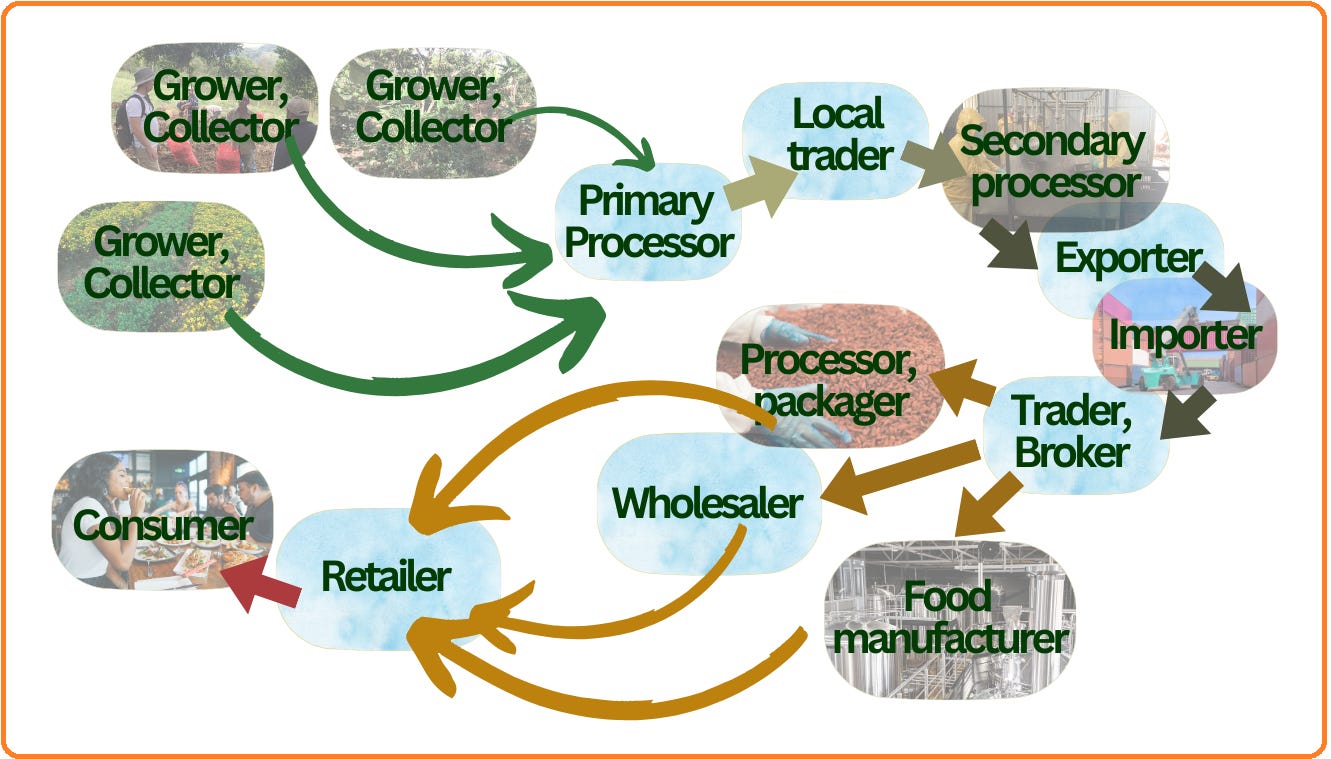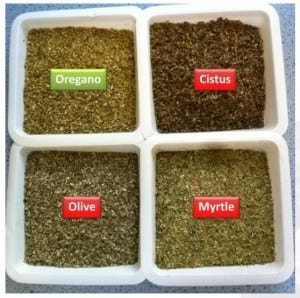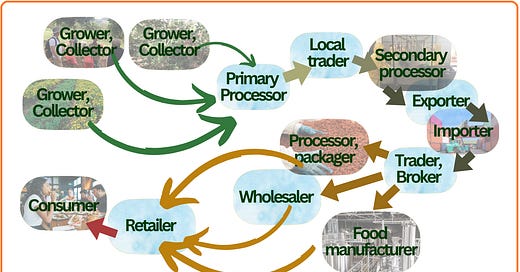150 | What it's like to get E. coli from a sandwich | Fraud in herbs and botanicals
Plus join our next meetup, take three for the sea
This is The Rotten Apple, an inside view of food integrity for professionals, policy-makers and purveyors. Subscribe for weekly insights, latest news and emerging trends in food safety, food authenticity and sustainable supply chains.
Save the date: Meet-up on Thursday 15th August;
Herbs and botanicals food fraud overview;
What it’s like to have an E. coli gastric infection;
Food Safety News and Resources;
Take Three for the Sea;
Food fraud news and recent incidents
Wow, thank you so much! Shoutout to 👏👏 Nelma, Alyssa, Nicolas and CPiers*** 👏👏 who became paying subscribers, and to Teresa, Theresa, Ina and Sophie who renewed their paid subscriptions recently. I couldn’t do this newsletter without people like you, you’re the best.
Welcome to Issue 150 of The Rotten Apple.
This week’s issue explains what it feels like to have a pathogenic E. coli infection. Maybe don’t read while eating. Plus, an introduction to fraud in herbs and botanicals, including the latest approach to testing for identity and purity.
As always, paying subscribers get food fraud news and there is lots of food safety news in our free weekly roundup.
Thank you for being here.
Karen
P.S. If you love this newsletter, please tell your friends and colleagues about it and help grow our community of global food safety champions.
Save the date: Meetup 15th August, 2024
Our next meetup is on Thursday 15th August, next week. Everyone is welcome.
Fraud in herbs and botanicals
Herbs (when grouped with spices) are among the top ten most fraud-affected food types, while dietary supplements, which often contain herbal ingredients, are also in the top ten (source).
Food authenticity experts differentiate between herbs used for cooking, called ‘culinary herbs’ and herbs used in herbal medicine preparations, often called ‘botanicals’.
What are herbs, exactly? They are pieces of plants that, in the case of culinary herbs, impart organoleptic properties to food, and for botanicals, have properties that are valuable in traditional medicine. Certain plant materials, such as turmeric could be considered both a herb and a botanical – although many of us would consider it a spice rather than a herb.
The WTO definition of herbs includes powdered seeds and bark, meaning materials such as cardamom and cinnamon are counted as herbs as well as spices (confusing!).
Herbs are: “Crude plant material such as leaves, flowers, fruit, seed, stems, wood, bark, roots, rhizomes or other plant parts which may be entire, fragmented or powdered.” (WTO, 2000). A botanical is “a substance obtained from a plant and used typically in medicinal or cosmetic products.” (source).
Why so vulnerable?
Dried herbs and botanicals are particularly vulnerable to food fraud for three reasons:
They are high-value materials, so fraudsters can make significant financial gains by diluting, adulterating or misrepresenting them.
They have complex and long supply chains, passing through many different hands, and with many different points where they can be adulterated or misrepresented.
They often have a physical form – powder or flowable pieces - suitable for dilution with fillers or adulteration with enhancements such as dyes or pigments.

What does fraud in herbs and botanicals look like?
In herbs and botanicals, fraud can take the form of:
Adulteration (dilution) with other plant material, for example, adding olive leaves to dried oregano or sage;
Adulteration of botanicals with food dyes, for example St John’s wort extracts adulterated with amaranth, brilliant blue, sunset yellow and tartrazine;
Adulteration of “natural” herbal supplements with pharmaceutical drugs such as sildenafil (Viagra);
Substitution of plant species, for example tejocote root replaced with toxic oleander;
Misrepresentation of country of origin or organic status.
Oregano: a vulnerable culinary herb
Fraud in oregano has been reported for years. Stakeholders in the United Kingdom’s review of methods for herb and spice authenticity this year named it the herb or spice of most concern, followed by black pepper.
In 2020, testing of oregano from Turkey revealed one quarter of samples contained olive leaves, with two samples containing no oregano at all.
In 2021, 48% - almost half - of nearly 300 hundred oregano samples were deemed ‘suspicious’ in a set of tests by the European Commission’s Knowledge Centre for Food Fraud and Quality. Olive leaves were the most common adulterant (source).
In 2022, surveillance sampling in the United Kingdom revealed adulteration with leaves other than oregano – mostly olive leaves – at concentrations of up to 25% in 13% of samples.
Oregano supplies in Norway, the USA and Australia have also been affected by adulteration with non-oregano leaves.

While researching this post I learned that olive leaves used as adulterants in oregano often have high levels of pesticide residues. Of course, since olive leaves are not grown for human food, the pesticides are not approved for food use, and are not safe. This means that oregano adulterated with olive leaves presents a safety risk to consumers (source).
Did you know? Culinary herb supply chains are less vulnerable to climate change than other plant foods because they generally grow quite quickly and crops can easily be established in new growing areas as climate patterns change.
Vulnerable botanicals
Twenty suspicious botanicals and fungi have been listed by an analytic lab Alkemist, in the hope this will “make it harder for cheaters to cheat”. These are the materials that have most frequently failed identity testing (one presumes Alkemist’s testing) during the first half of 2024. The list includes:
Herbal supplement ingredients such as echinacea, reishi, elderberry, nettle and ashwagandha;
Domesticated (common) apple;
Lemon balm;
Watercress;
Olive;
Monk fruit;
Stevia;
Grape.
Elderberry (Sambucus nigra) is a “repeat offender”, having had the most testing failures in 2023. Apple (Malus pumila) is a new and unexpected addition to the list.
Alkemist did not publish information about the form of the listed items so we don’t know if they were powders or liquid extracts or dried pieces. The test methods used were HP TLC (high-performance thin-layer chromatography)-based.
Advice from the botanicals lab
To minimise exposure to fraud in botanicals, Alkemist recommends supplement businesses should…
Take care with the selection of suppliers;
Make sure purchasing specifications are rigorous when it comes to both identity and quality;
Test every delivery of every lot;
Scrutinise contract manufacturers in detail, requesting copies of all test reports and periodically checking products in a third-party lab;
Finally, when failures happen, Alkemist urges businesses to “do the right thing”.
Authenticity testing: there is no silver bullet
No one testing approach will work for all herbs, and a wide range of test methods are being used in industry. These various methods are commonly based on spectroscopy, mass-spectroscopy and DNA methods,
Purchasers of culinary herbs are beginning to adopt a two-tiered approach to testing (source). Two-tiered testing involves an initial screening test – usually spectroscopic - that can be done quickly in-house and will flag potentially problematic samples. Any problematic samples from the screening are then sent away to an outside laboratory for more in-depth authenticity testing.
Fourier-transform infrared spectroscopy (FTIR) and Near-infrared spectroscopy (NIR) methods are the most common screening methods used in the United Kingdom (source).
Sources and further reading
The PT Panel (2024) | Assuring the integrity of herbs and spices – challenges and best practice. Webinar hosted by LGC Axio, available at https://www.foodauthenticity.global/events/recording-available-assuring-the-integrity-of-herbs-and-spices
United Kingdom Food Standards Agency (2024) Review of methods for the analysis of culinary herbs and spices for authenticity. Available at: https://doi.org/10.46756/sci.fsa.fod541
NutraIngredients USA (2024). Alkemist Labs releases ingredient ‘watch’ list. Available at: https://www.nutraingredients-usa.com/Article/2024/06/18/Alkemist-Labs-releases-ingredient-watch-list .
American Botanical Council (2023). The Supply Chain – A Deeper Look. Available at: https://sustainableherbsprogram.org/explore/supply-chain/the-supply-chain/
The American Botanical Council’s Botanical Adulterants Prevention Program (BAPP) resources.
What it’s like to have an E. coli infection
Use this in your next food safety training session
This is the story of a man who was sickened in the Escherichia coli supermarket sandwich outbreak in the United Kingdom in May and June this year.
His symptoms were pretty awful but I thought it was worth sharing because there is still a perception among the general public that the symptoms of foodborne illness are always simple diarrhoea and vomiting. Not true! Hospital visits, miscarriages, kidney failure and neurological symptoms like memory loss and light sensitivity can also result from foodborne infections.
Many frontline food workers don’t know about the more serious symptoms experienced by food poisoning victims, and this can contribute to workers underestimating the importance of protecting consumers.
Stories about real consumers and their experiences help trainees understand the ‘why’ of food safety, and such stories are easier to remember than faceless facts and figures. Today’s story has a human face, some nasty symptoms and – fortunately – a happy outcome.
Matt Jenkins, of Kent in England, contracted an E. coli infection after eating sandwiches in a foodborne illness outbreak in the United Kingdom in May and June 2024. The E. coli is thought to have been in the lettuce used in the sandwiches.

After becoming ill Matt experienced pain “so bad he thought he was going to die”. He had bloody diarrhoea, a symptom typical of pathogenic E. coli, and was passing blood up to forty times per day. This continued for multiple days.
The pain, he said was “unbearable”. He had stomach cramps that were so bad he passed out from the pain and was admitted to the hospital after attending the emergency department in agony.
After hearing this story, and learning more about what it’s like to have a serious foodborne illness, frontline workers will get a better understanding of why we are so passionate about food safety.
Source: Fuller, C. (2024). Kent man with E. coli tells how he thought he was going to die. [online] Bbc.com. Available at: https://www.bbc.com/news/articles/cpe3kp5wnqko [Accessed 4 Aug. 2024].
Food Safety News and Resources
My weekly food safety news roundups are free for everyone.
I curate only the most interesting food safety news and serve it up in bite-sized chunks, ad-free and easy to read. This week’s news roundup includes updates on the deadly Listeria deli-meat outbreak in the US, guidelines for deforestation rules for Europe, new information about chemical migration from food contact items, more data about heavy metals in chocolate and more.
Click the preview below to read.
Take (more than) three for the sea (just for fun)
In my home town of Sydney, Australia, we do a thing called “Take three for the sea”. Every time you go to the beach or shoreline, you pick up three pieces of garbage from the sand and dispose of it properly. In return, we get a cleaner beach and a warm glow.
In the Philippines, when they pick up garbage from the sea they get rice to eat!
The Philippines is the world’s largest contributor of plastic waste to the ocean, according to Our World in Data (2022), responsible for 36% of global ocean plastic waste. Green campaigners have implemented a novel solution at a Philippines diving and coral reef area, giving rice to local people who collect plastic rubbish from the beach.
Below for paying subscribers: Food fraud news, horizon scanning and incident reports
📌 Food Fraud News 📌
📌 Food Fraud News 📌
In this week’s food fraud news:
📌 Wine made from juice, alcohol and dye;
📌 Citrus fruits “irregularly traded”;
📌 Cocoa bean smuggling;
📌 Cheese, red yeast supplements, tuna, spices, wines, premium spirits and more.






